ARCHIVE
JOHN CURRIN
interview by Catherine Wood
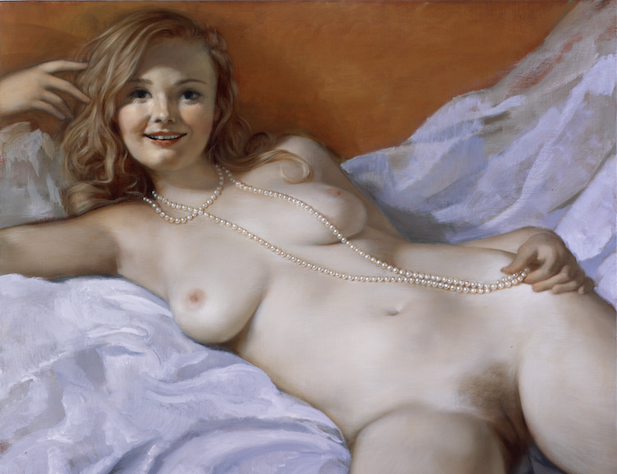
Courtesy of the artist and Sadie Coles HQ, London
CATHERINE WOOD You once said that you felt Picasso wanted to see the arse, the tits and the vulva of the female nude spread out on one plane of vision.
JOHN CURRIN My point was that Cubism was not about a scientific enquiry into quantum mechanics of perception or multiple points of view and their scientific implications, but was a basic desire to sexually dominate his subject. Innovations like Cubism came out of base sexual urges rather than intellectual considerations. I try and not deny the simpler, baser urges in painting. The temptation is to think your way into a good painting.
CW Working within a culture in which the sexualization of images is the dominant feature of how we read the world visually, what does it mean for you to make these images as paintings?
JC I’d like to say that I’m critical of that but also I’m a victim of it. I paint the way I do because that’s the landscape I inhabit. Part of it is just reflecting the constant prurient provocation.
CW Then who are your images of women for? They don’t seem as though they’re for women.
JC I’ve never been able to figure that out. I was reading something about David Salle in which the author said that they always thought of his paintings as pictures of men looking at women. It has something to do with that. A picture of myself looking at women.
CW So you’re using this framework of painting, which is probably the most fetishized kind of image-making with its “handmadeness.” It’s easy to make images mechanically now, but you’re choosing a difficult way, and a slow way. Are they designed to be looking back at you, as you say, but not critically? I’m thinking of the pornographic paintings you exhibited at Sadie Coles last summer.
JC Sitting around my studio was some hilarious 1970s-era Danish pornography, and I started making paintings from those images while I was thinking about Denmark and Europe, and they became an elegy toward my idea of European liberal life.
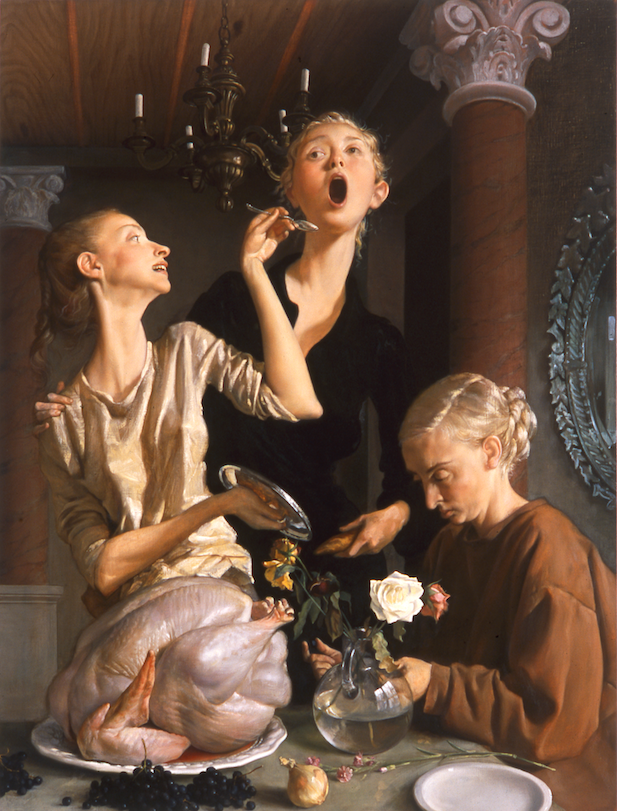
Courtesy of the artist and Marc Jacobs
CW Could that be related to the idea that you have described about figurative painting being connected to its European legacy more than to American Abstract-Expressionism and its associated masculinity? Which artists do you feel most connected to, past or present?
JC Courbet is the person I come back to the most. He is not the greatest artist, but he is the one that I feel closest to.
CW More than Manet?
JC Yes, Manet’s the greater artist but Manet I find much more like Picasso, in that he’s not really approachable. I find him intimidating to emulate. Also on my mind is Singer Sargent, though his works do nothing for me. Anyway, I’ve always found Courbet’s clumsy, self-taught approach more adaptable to being an American, because being an American painter is a kind of an oxymoron; the medium consists of a lot of European mannerisms. There’s a movie called Dirty Rotten Scoundrels in which Michael Cain tries to teach Steve Martin how to be European. It’s always reminded me of trying to paint. That was another reason I did those porn paintings: they gave me an opportunity to try and make a kind of 19thcentury French painting. One thing I like about porn is that it’s usually lit from all angles; there’s no shadows. It’s interesting to recapture those with a light source with a god-like directional light.
CW Gerhard Richter said photography is the best image of reality we’ve got. But also he saw himself as a Pop artist, originally. Do you see yourself as a Pop artist?
JC I don’t know what a Pop artist is, except as someone who uses imagery that’s popularly available. There’s a reactionary aspect to my work that doesn’t fit in with Pop art. My desire to be a romantic European artist who paints naked girls in a studio, and my idea of the pleasure of painting, contradicts any kind of Pop —especially the Warholian approach.
CW You’ve been given a hard time about using naked images of women. Do you feel you have had, and deserved, a hard time on feminist grounds?
JC Well, yes. But nothing particularly crippling. It does make me self-conscious and it hurts my feelings, and I feel guilty about it.
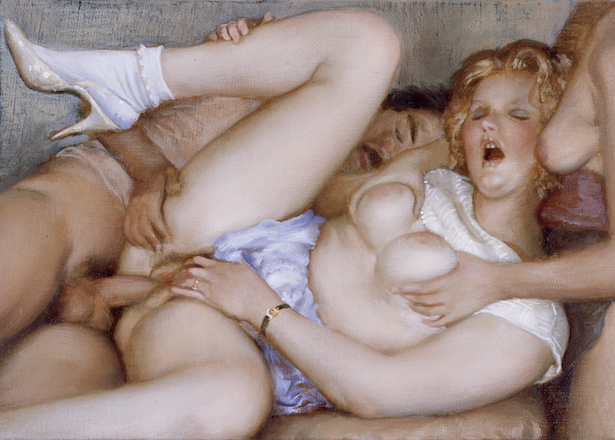
Courtesy of the artist and Sadie Cole HQ, London
CW Something about your work makes me feel that you see painting as a guilty pleasure. Especially the ones of the women with the overinflated breasts that are very smooth and the impasto faces. It’s to do with the overworked nature of the surface combined with the imagery.
JC You just end up assigning a meaning to things. The face and the idea of the palette knife is the idea of being unable to perfect, of damaging something by loving it. The more you touch a palette-knifed surface, the more you mortify and mess it up. It’s the thought that you can love a face and destroy it with your love. Whereas the breasts have more of the strangeness of Florentine painting, where everything is made out of the same material and there’s a kind of ideal Euclidean, inhuman geometry to things, where you can say I like big breasts and it becomes abstracted and absurd without any real human complications or consequences in a way that the faces do have consequences. That sounds like mumbo jumbo but that’s the basic duality going on in the paintings.
CW A male friend of mine said of your pornographic paintings that it is odd to take an image intended in a functional way — as a trigger to sexual arousal — and elaborate or elevate it into this weird, anachronistic, handmade picture to be looked at in a gallery.
JC You mean for masturbation?
CW Yes.
JC That’s not an unusual strategy for artists now to take something and remove its function. You see it in sculpture all the time. Or in performance art, where people have meaningless work being done by laborers as a message of futility. I didn’t mean thatbutitisintheair.Partofitisthe guilt and part of it is trying to take control of lustful images that have this automatic physiological effect on me and on men, and then redeem them. But that’s a conversation to have with a shrink.
CW It’s okay, I won’t tell anyone. [Laughs]. But I think the “use” of pornography is different than the functionality of a urinal in terms of affect.
JC Here’s a metaphor: If you’re given a Leonardo painting of a nude that you’ve never seen before, and a nude photograph of your neighbor that you’ve been wondering about for five years, the picture of the neighbor is going to be more compelling. I always found it funny that painting cannot compete with even the crumbiest, most mundane photograph. But, for me, porn is one way of engaging photography. A larger question is of the battle between photography and the painter. In my paranoid view photography represents the state or society, and painting represents the individual. Porn is the most vicious, dangerous, affective and militarized agent of photography. It’s the one that gets into your brain — at least it gets into mine.
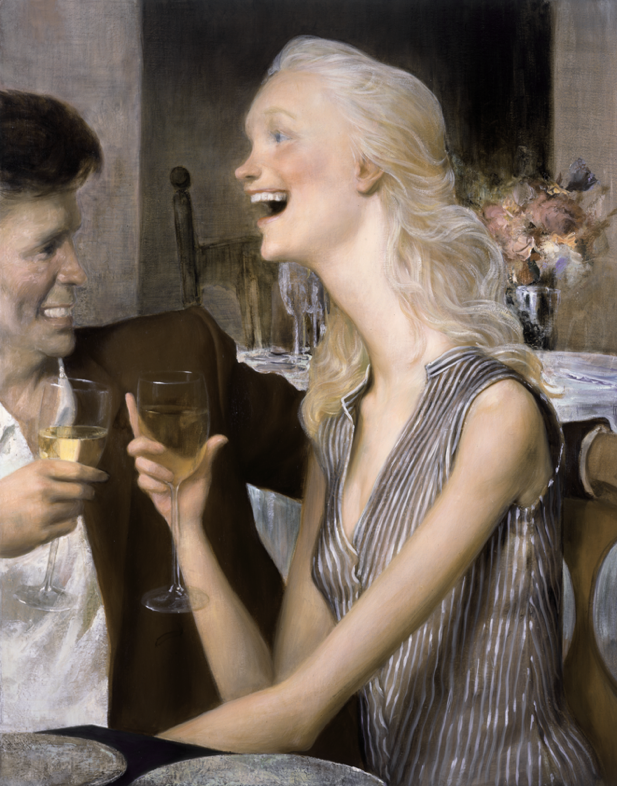
Courtesy of the artist and Sadie Coles HQ, London
CW You shifted in recent years from using photographic sources to live models. Some of them are your wife, right?
JC I used Rachel in my paintings more because our studios were in the same building and she was available. And the image of her face has always naturally come out of my hand, and she is very beautiful. But more than being beautiful there is just something inevitable to me about her features. It’s a little bit like if François Boucher has this face that he puts on every single woman or person…
CW Is there a relationship between being married and being a figurative painter? Making a feature of the marriage by painting your wife seems to me to be tied up with figurative painting and its conservativeness.
JC That got complicated. There were paintings where I had put Rachel’s face in and that made me uncomfortable because they were not about Rachel, and they were maybe a harsh image of a woman, maybe mocking. I got attacked for being sexist, and they’re partly right: there are paintings that are not sweet. I sound like I’m evading something but I’m not — I’m trying to put it right. They are about feelings, they are about women and a lot of times they are hostile. I wouldn’t say hostile, but troubled.
CW Conversely, the couples paintings, the gay couples included, feel so drained of sex. It was the cozy domestic thing that made them feel like they were married to me.
JC It was an image of marriage for me. I think you are talking about Homemade Pasta (1999), which was meant to be a counterpoint to all those images of Northern-European-looking Venuses in the same show. I had just gotten married and I wanted a relatively sexless image of celestial nude beauty, and then an image of marriage and domesticity without sex. I chose gay couples because, personally, I couldn’t put anything in there; there was no woman to project the lust onto. I am interested in images of men for that reason. I’ve never been able to make pictures of men into power images, like Tintoretto.
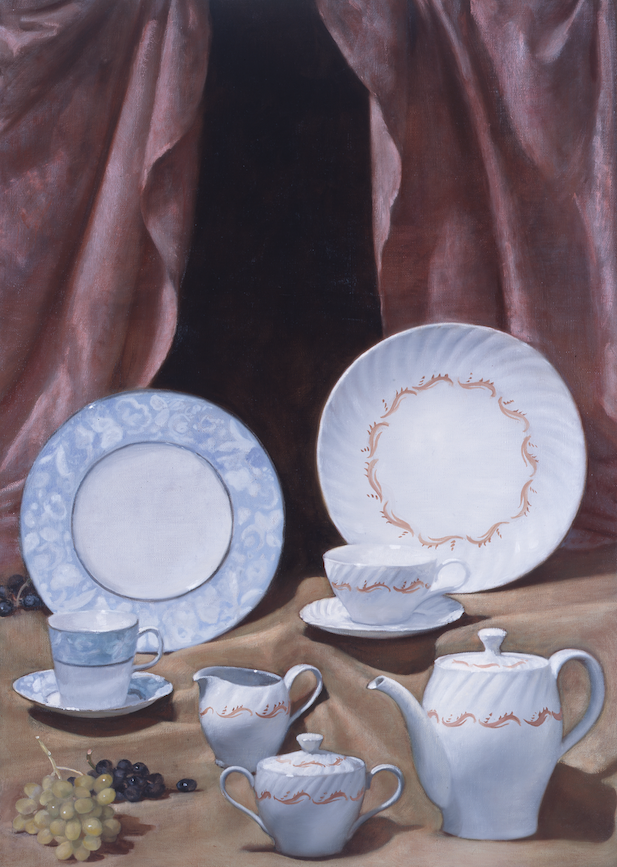
Courtesy of the artist and Sadie Coles HQ, London
CW So you’ve got this wilted image of masculinity and the pneumatic femininity.
JC One precedent to this is Russ Meyer movies from the 1970s. You have gigantic-breasted women with goodlooking, dumb, weak men, and the women outsmarting them, bossing them around and dominating them. I imagine the more you look at the movies you say that he got it totally wrong and it’s a crude image of dominating women. But they’re hilarious and they’re effective and I always liked to watch them just to see the women. But I do find myself liking Venuses and ridiculous men populating the paintings. Which is basically me as the ridiculous man and the Venuses as everybody else, I guess.
CW I wanted to ask about the surface of your paintings and skin, and the question of sensuality in terms of how they’re made.
JC I don’t have a set way of doing it. To an extent I have a method that goes from one painting to another, and generally with flesh I work up the form in black and white or green and white, then change things around when I like the form, by putting on color sort of translucently. Pinks and yellows. And that is easier to do with a live model in front of you.
CW Looking at the skin and painting?
JC Yeah, it almost feels like cheating or something. Like this is too easy. But I change my way of working by using a slipperier paint, something that doesn’t get sticky over seven hours.
CW Is there a pleasure in that process, or is it just the result that you’re looking for?
JC It is intensely pleasurable; painting is one of the most fun things that you can do, when it is going well. When it’s going badly it’s hard to say, but when I’m painting well and I have a model and I don’t have to think, I can just look at her and paint.



